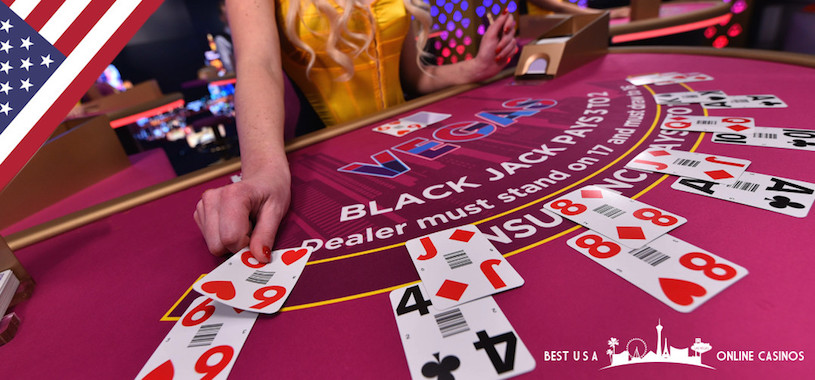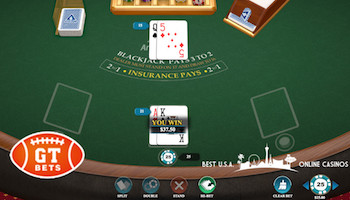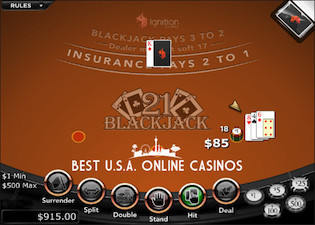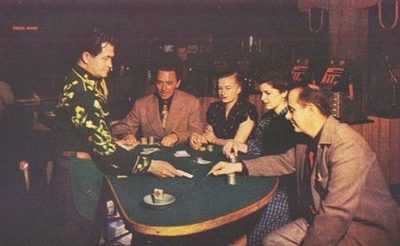
***Updated: November 21st, 2020***
It’s no surprise blackjack is the most popular casino game in the country since in order to win, a perfect balance of skill and luck are required. Sure rookie players can go on amazing runs hitting on hands they shouldn’t have, while veterans sit beside them busting out using “optimal strategy“, but that’s just how it goes sometimes.
The following list of best blackjack U.S. online casinos is updated regularly, with rankings changing depending on welcome bonuses, payout timeframes, or if alternative versions are added. Some people prefer Switch or Double Attack to classic, so accessing a healthy variety of options is also important. All sites below are fully recommended and guaranteed to pay winnings, the most trusted operations in the iGaming industry today.
Nowadays, most Americans play 21 online instead of at brick and mortar establishments. It’s possible to get on tables immediately, without wasted time sitting in traffic or finding parking, and it can be played anywhere on a smartphone, whether at a beach or waiting for the dentist. Not to mention, free money in the form of bonuses is usually extended to new members and multiple variations are on offer, 24 hours a day.
Another huge advantage of virtual products is the ability to multi-table and enjoy simultaneous tables at the same time, with some places allowing up to eight. They don’t have to be the same so it’s possible to also sit at Let It Ride, Three Card Poker, or any slot machine while splitting
and doubling down
.
USA Real Money Online Blackjack
Constant research is necessary to only rank sites offering the best real money online blackjack in the United States, requiring at least five unique versions to make the cut. Virtual cashiers are used to make deposits and withdrawals, with descriptions of current banking methods, including approximate 3rd party fees for using each.
Funding accounts is very simple thanks to cryptocurrency, allowing players to move money quickly and securely from “electronic wallets” to sites with just a few clicks of a button. It’s a little intimidating starting off, but once a few transactions are completed it’s easy to understand why so many have chosen to gamble with Bitcoin, never leaving records of what’s been sent. Many sites even offer higher bonuses for utilizing crypto since they are much easier to process. Amounts begin and end as real cash, only temporarily converting to digital until received.
Pro Tip: Enjoy a few hands of practice blackjack courtesy of the legit MyBookie U.S. Casino to learn how to split
and double down
, and when to stay
.
Those not convinced of how great Alt Coins are, it’s possible to play online blackjack with VISA or other cards like MasterCard or American Express. Remember though, fees for transactions are passed on to clients and deducted from amounts, sometimes as much as 9%, depending on location. Additionally, if banks realize what purchases are for, future ones are blocked, necessitating finding a different solution.
The only method more cumbersome than the above occurs when using Western Union for blackjack and initiates a Person to Person transfer to send funds. A few places still accept money orders but they take up to 24 hours to be received and fees are astronomical, so better options exist. If speed isn’t important and spending extra cash isn’t a deterrent, head down to a local WU office and fill out the forms, but just make sure to get beneficiary names and addresses of receivers prior to attempting.
Rules of 21
Blackjack is played against the House and not others, with land based tables usually offering seven seats, allowing 1 to 7 customers to participate. Stakes are placed before anything is dealt, according to predetermined limits. After chips are placed, two cards are delivered face-up to everyone, including dealers, except their second is face-down and unexposed. This last draw is known as the hole card.
The ultimate goal is to construct a hand value closer to 21 than the dealer, without exceeding it. Aces are either high (11) or low (1), selected at player’s discretion. Face cards count as ten and the remainder of the deck is worth the numbers indicated. If someone is dealt an Ace and any 10, Jack, Queen or King, the total is a blackjack and an automatic winner paying out at 3 to 2 odds. All other player wins are even money and ties are a push resulting in refund of original stake amount, except for a two-card BJ which is always victorious.
 If nobody has 21 after the deal, it’s time to build a hand towards this value to face off against the House. An individual can opt to hit and take additional cards or stand and cease drawing. In situations where the outcome is forced over 21, hands “bust” and stakes are lost.
If nobody has 21 after the deal, it’s time to build a hand towards this value to face off against the House. An individual can opt to hit and take additional cards or stand and cease drawing. In situations where the outcome is forced over 21, hands “bust” and stakes are lost.
Once everyone makes their decisions, the dealer reveals the hole card and acts according to table rules. A vast majority of places require they take a card showing anything less than 17 and cannot hit on totals of 18, 19 or 20. Deviations from these rules are highly unconventional, although some require standing on a “hard 17” (10 / 7) and necessitate hitting on a “soft 17” (Ace / 6), while others may dictate standing on all 17s. When the dealer finishes acting, bets are resolved and a new round begins.
Two opportunities for raising and getting more chips on the felt are available. Firstly, following receipt of the first two cards, a decision can be made to “double down“. In this scenario, only one final card is dealt, completing the final total. Doubling also requires enlarging initial stakes by 100% in order to “double” it. The most statistically profitable move is doubling down on 11s, which should be done every time it appears.
Another prospect for financial expansion comes from receiving two identical cards by “splitting” them into two separate hands. The second must be staked at original value and each is played out separately, with doubling and splitting a possibility on each, always necessitating further investment as action progresses.
Variations
Within standard rules, many different variations exist offering unique twists. In European, dealers only receive one card face-up and doesn’t receive a second until after those seated make decisions. Since a result of 21 automatically wins, extra chips on splitting and doubling could be in trouble.
A variant called Double Exposure delivers both dealer cards face-up, which of course dramatically changes the strategy to employ. While in Spanish Blackjack, all 10s, Jacks, Queens and Kings are removed from the deck and hands of less than 21 formed using five or more cards are supreme.
 New Jersey started to extend a surrender option as gambling was being legalized in the 1970s, enabling customers to muck weak hands and forfeit half of stake amount. This has spread around the world due to its popularity among meek and timid people who are easily bullied out of their bankrolls.
New Jersey started to extend a surrender option as gambling was being legalized in the 1970s, enabling customers to muck weak hands and forfeit half of stake amount. This has spread around the world due to its popularity among meek and timid people who are easily bullied out of their bankrolls.
Others feature rules on how many hands may be split, or restrict doubling to results of 9, 10 or 11. Some variations do not make busting an automatic loser, for instance, if a player busts with a total less than the dealer’s, only half the stack is lost.
A side bet that has now become standard is “insurance” which is offered by the House any time a dealer’s up-card reveals a chance of getting 21. If they check the hole and it contains one it pays 2 to 1, otherwise insurance is lost and action proceeds normally. Experts agree accepting insurance is the worst decision one could possibly make.
Blackjack Strategy
For hundreds of years Twenty-One was enjoyed by people blissfully unaware of probabilities and hard numbers behind their choices. That all changed in the 1960s when four United States Army servicemen possessing excellent mathematical skills set out to develop an ideal approach for playing blackjack, simply using pencils, paper, and primitive adding machines to complete the task.
The result was a basic strategy formulated from numerical trials stating exactly which decisions should be made in every conceivable combination of cards received. Over time, little has changed on these strategy charts and while the originals are almost identical to those being studied today, one can reduce losses to a mere 0.5% during long sessions, which is much better than average.
 Strategy charts for other 21 variations also exist, but it’s fair to assume online casinos didn’t introduce alternatives for charitable reasons. Therefore, new versions always arrive with built-in House advantages of varying degrees.
Strategy charts for other 21 variations also exist, but it’s fair to assume online casinos didn’t introduce alternatives for charitable reasons. Therefore, new versions always arrive with built-in House advantages of varying degrees.
Experts took basic strategy and added an analysis of what came out of the deck to move the edge from “slightly in favor of House” to “slightly in favor of player”. Known as counting cards, this tactic actually results in it being the only Las Vegas attraction extending a possible advantage to customers.
Although the concept of counting cards is simple, execution on a busy floor is not always easy and many so-called counters have surprised themselves by losing. Either way, pit bosses throw out and ban cheaters if caught, so stick to smart, legal strategies instead.
Obviously, never try this online since softwares reset and deal from “new” decks after every round, making counting impossible.
History
It’s easy to imagine how everything came together. Given a deck of primitive playing cards, the first thing people would naturally do is draw them out one by one against each another in an effort to pull the highest. After becoming bored, drawing two, then more, and so on is a reasonable next step.
The highest total of two cards is 20 but if all faces were made to count as ten, it would have been too common, so Aces were assigned a dual value of 11 and 1 to create a potential maximum of 21. It eventually morphed into the version known today.
Although it’s a great theory, no one knows how it came to be as its true origins weren’t documented. Experts usually point to similar amusements found in Spanish literature dating back 500 years. For example, Miguel de Cervantes, who wrote Don Quixote: The Ingenious Gentleman of La Mancha, was apparently a bit of a punter and mentioned seeing diversions similar to 21 in his writings from the early 1500s.
Regardless of inception, it was spread by travelers and tradesmen landing in American West saloons in the 1800s. French diversion Faro was a frontier passion in those days, accounting for more revenue than all other forms of gambling combined. In order to promote the little-known game of Twenty-One, some proprietors extended an outrageous payout of 10-1 for any 21
formed with an ace of spades and a black jack. Unsurprisingly, blackjack
quickly became the accepted name in dusty drinking holes, still present in our vocabulary today.










